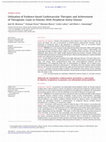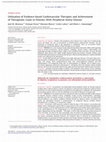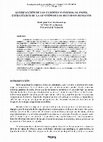Papers by Maria Samaniego

Revista Española de Cardiología, 2012
Introduction and objectives: Patients with peripheral artery disease have a high risk of cardiova... more Introduction and objectives: Patients with peripheral artery disease have a high risk of cardiovascular events and death. The rate of prescription of evidence-based cardiovascular therapies and the attainment of therapeutic goals in this population is suboptimal. There are no previous studies evaluating the rate of prescription of these therapies in our country. Methods: PERIFERICA is a cross-sectional study conducted from May to December 2009 in 440 outpatient clinics of general practitioners, internal medicine, cardiology, vascular surgery, endocrinology, and nephrology specialists throughout Spain. Subjects were included if they were aged 45 years and had peripheral artery disease and a blood sample obtained during the previous 6 months. Patients were excluded if they had coronary or cerebrovascular diseases. Clinical and anthropometric variables and blood analysis were obtained in all participants. Results: In total, 4087 patients were included in the study (mean age, 68 years; 74% men). There was a high prevalence of diabetes (50%) and hypertension (90%); 79% of participants received lipid-lowering drugs (76% statins), 85.5% antihypertensive drugs (66% renin-angiotensin blockers) and 83% antithrombotics (75% antiplatelet drugs and 11% anticoagulants). In addition, 30% of subjects had a low-density lipoprotein cholesterol concentration n<100 mg/dL, 29.5% had optimal control of blood pressure, and 74.5% did not smoke. Only 8% had a good control of all of their cardiovascular risk factors. Conclusions: Although a high percentage of subjects with peripheral artery disease receives adequate treatment with evidence-based preventive therapies, the percentage of subjects with good control of all their risk factors is low.

Revista Española de Cardiología (English Edition), 2012
Introduction and objectives: Patients with peripheral artery disease have a high risk of cardiova... more Introduction and objectives: Patients with peripheral artery disease have a high risk of cardiovascular events and death. The rate of prescription of evidence-based cardiovascular therapies and the attainment of therapeutic goals in this population is suboptimal. There are no previous studies evaluating the rate of prescription of these therapies in our country. Methods: PERIFERICA is a cross-sectional study conducted from May to December 2009 in 440 outpatient clinics of general practitioners, internal medicine, cardiology, vascular surgery, endocrinology, and nephrology specialists throughout Spain. Subjects were included if they were aged 45 years and had peripheral artery disease and a blood sample obtained during the previous 6 months. Patients were excluded if they had coronary or cerebrovascular diseases. Clinical and anthropometric variables and blood analysis were obtained in all participants. Results: In total, 4087 patients were included in the study (mean age, 68 years; 74% men). There was a high prevalence of diabetes (50%) and hypertension (90%); 79% of participants received lipid-lowering drugs (76% statins), 85.5% antihypertensive drugs (66% renin-angiotensin blockers) and 83% antithrombotics (75% antiplatelet drugs and 11% anticoagulants). In addition, 30% of subjects had a low-density lipoprotein cholesterol concentration n<100 mg/dL, 29.5% had optimal control of blood pressure, and 74.5% did not smoke. Only 8% had a good control of all of their cardiovascular risk factors. Conclusions: Although a high percentage of subjects with peripheral artery disease receives adequate treatment with evidence-based preventive therapies, the percentage of subjects with good control of all their risk factors is low.

Actualmente, las empresas se mueven en un entorno que se caracteriza por unos niveles de competen... more Actualmente, las empresas se mueven en un entorno que se caracteriza por unos niveles de competencia cada vez más intensos. Para que la empresa pueda conseguir el éxito en este entorno tan competitivo y cambiante es preciso, entre otras cosas, una competencia distintiva entendida como "lo que la empresa hace mejor" y lo que la empresa hace está basado en lo que la empresa sabe, el conjunto de dichos conocimientos reside en los miembros de la organización y que se desarrolla mediante adecuadas políticas de personal, esto es lo que va a determinar el valor estratégico de una competencia esencial. De todo esto se podría deducir que los recursos y capacidades poseedores y potenciadores de dichos conocimientos y habilidades son en sí mismos factores estratégicos. Yesos recursos son tanto el capital humano, como las políticas de recursos humanos. En este orden de cosas, en el presente trabajo nos centraremos en el directivo de ventas en la medida en que es un recurso de la empresa caracterizado por ser escaso, no imitable y difíilmente sustituible. Entre las distintas herramientas de que dispone la empresa utilizaremos el marketing interno para ofrecer al directivo de ventas (cliente interno) unas condiciones de trabajo que le satisfagan y motiven vía retribución, formación, promoción y estabilidad en la relación. PALABRAS CLAVE: Enfoque de recursos. Directivo de ventas. Marketing interno. Gestión estratégica de los recursos humanos. Garrido Sama niego, M. a J. y Pérez Santona, M. a P.
Downloadable! The objective of the current work is to analyze how the characteristics of cultural... more Downloadable! The objective of the current work is to analyze how the characteristics of cultural activities promoted by museums (group composition, group dynamics, duration, theme, venue, new technologies) and service quality affect the emotions experienced by participants and ...
Journal of Management Development, 2007
... to generate funds by organizing temporary exhibitions and large-scale events, encouraging don... more ... to generate funds by organizing temporary exhibitions and large-scale events, encouraging donations, etc ... and Kotler (1996) and Voss and Voss (2000), who recommend arts leaders to ... O., Avci, T. (2003), &amp;quot;The effect of management commitment to service quality on employees&amp;#x27;s ...
Immunobiology of HLA, 1989
Transplantation, 1996
... Ferraris, Jorge R.2; Tambutti, Monica L.; Redal, Mariana; Ramirez, Jose A.; Carlin, Maria C.;... more ... Ferraris, Jorge R.2; Tambutti, Monica L.; Redal, Mariana; Ramirez, Jose A.; Carlin, Maria C.; Samaniego, Maria C.; Prigoshin, Norma. ... JR; Pasqualini, T; Alonso, G; Legal, S; Sorroche, P; Galich, A; Coccia, P; Ghezzi, L; Ferraris, V; Karabatas, L; Guida, C; Jasper, H Pediatric ...
Endocrinología y Nutrición (English Edition), 2014
Thyroid metastasis from clear cell renal carcinoma * Autor para correspondencia.
Endocrinología y Nutrición, 2014
Thyroid metastasis from clear cell renal carcinoma * Autor para correspondencia.
Cirugía Española (English Edition), 2015
Introduction: Surgery is one of the high-risk areas for the occurrence of adverse events (AE).
Cirugía Española, 2015
Introduction: Surgery is one of the high-risk areas for the occurrence of adverse events (AE).
Uploads
Papers by Maria Samaniego